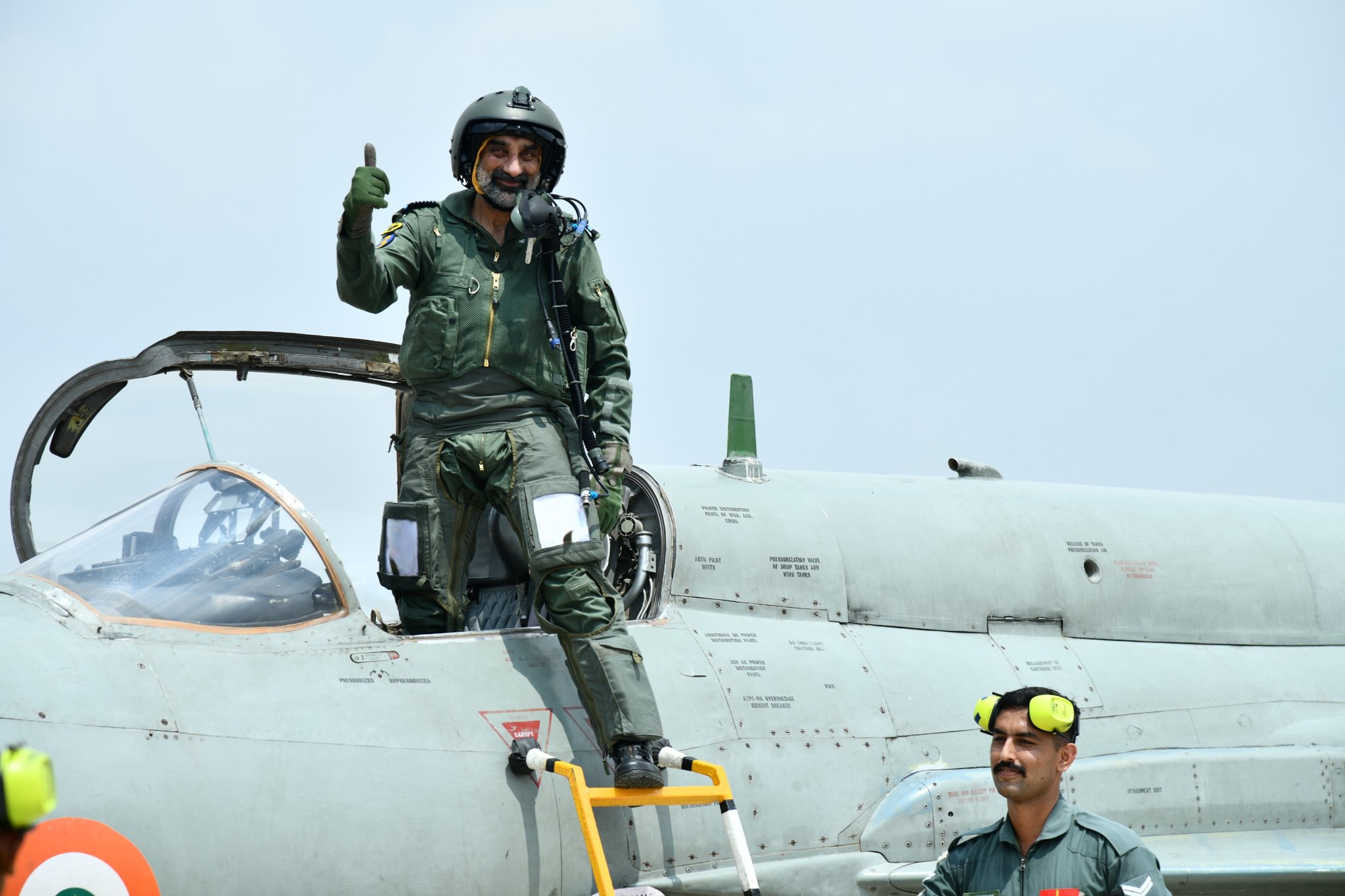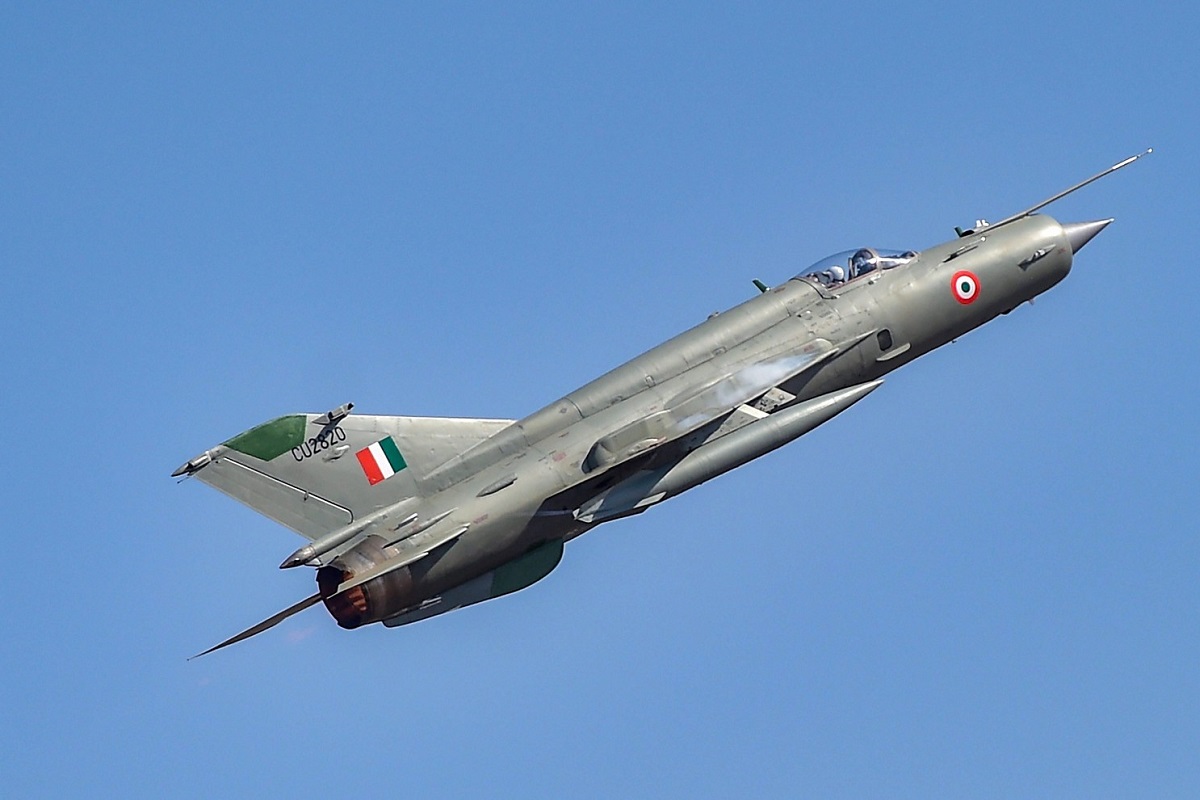As a tribute to the MiG-21, the Indian Air Force (IAF) chief, Air Chief Marshal Amar Preet Singh, flew solo sorties on the legacy aircraft earlier this month. The fighter, which is set to fly into the sunset in September 2025, will go down in history as an aircraft that downed “all generations of fighter jets.”
“Honouring the enduring legacy of MiG-21, the Chief of the Air Staff visited No. 23 Sqn, ‘Panthers’, the last squadron operating the legendary fighter.
The CAS flew a fighter sortie and also led a formation in a display led by Sqn Ldr Priya, symbolising both tradition and transformation. On 26 September 2025, the MiG-21 retires after six decades of glorious service in the IAF,” the service said in an official statement on August 25.
Speaking fondly of the aircraft, the Chief of the Air Staff said, “The MIG-21 has been the workhorse of the Indian Air Force. It was inducted in 1964 and has continued in service ever since. My first flight in a MiG-21 was in 1985. It was a simple yet remarkable aircraft to fly, though it demanded rigorous training.”
Separately, the IAF Spokesperson Wing Commander Jaideep Singh disclosed that the aircraft was deployed in an ‘operational’ role during the May 2025 Operation Sindoor, while speaking to ANI at the Nal Air Base, Bikaner, Rajasthan.
The Spokesperson also noted the stellar role that the MiG-21 Bison played during the Balakot strike when the IAF jets launched air strikes on a Jaish-e-Mohammed (JeM) terrorist facility in Pakistan in 2019.

“It was involved in 2019 in the Balakot attack, where Abhinandan had shot down an F-16 fighter aircraft, and then, coming to 2025, Operation Sindoor, it was deployed operationally for its use,” Singh told ANI.
“MiG-21 has a history of shooting down all generations of aircraft. And the last one was the F-16, which was shot down. It had also shot down, in the 1971 war, the F-104s. The way the Indian Air Force has utilised the MiG-21 operationally, none of the air forces in the world have utilised.”
Bought from the Soviet Union and licensed produced in the country, the MiG-21 was one of the IAF’s most advanced fighters, facing off against Pakistan Air Force (PAF) aircraft like the F-86 Sabre, F-104 Starfighter, and Mirage III.
The aircraft was credited with several air-to-air victories during the 1971 war, scoring 4–5 kills in aerial combat, primarily on the Western Front, where most dogfights took place.
Russia’s NATO Bid Derailed! How Europe Blocked Moscow’s Trans-Atlantic Dream & Fueled Ukraine War
It was deployed in combat again during the Kargil War for close air support (CAS) and interdiction, targeting Pakistani bunkers, supply lines, and positions on peaks like Tiger Hill.
Although the heroes of this war were the Mirage-2000s, the MiG-21s played a crucial role by delivering unguided munitions against enemy positions.
Moreover, the MiG-21’s high speed and ability to operate at altitude made it suitable for quick reconnaissance runs, and the data from MiG-21s helped the IAF and Indian Army target key positions.
In 2004, the MiG-21 faced off against the US F-15 in the first edition of the Cope India 2004 military exercise. The American Eagles, who have zero losses and 100 kills to their name, were trounced by IAF fighter jets.
The MiG-21’s role in dominating the Pakistan Air Force (PAF) is widely documented, as also reported by the EurAsian Times on multiple occasions. However, the alleged downing of an F-16 by a MiG-21 during the aerial duel with the Pakistan Air Force in 2019 was the most significant. Incidentally, though, it remains the most widely contested.
MiG-21 Downed F-16?
The MiG-21 has seen action in various wars, but its most notable combat performance in recent memory is undoubtedly against the F-16.
The incident occurred on February 27, 2019, when Pakistan launched a counterattack following India’s airstrike on a Jaish-e-Mohammed (JeM) terrorist facility in Balakot, Pakistan, that was launched on February 26, 2019. This led to a large-scale air battle near the Line of Control (LoC) in the Jammu and Kashmir sector.
According to publicly available information, the IAF deployed a mix of combat aircraft, including MiG-21 Bisons, Mirage 2000s, and Su-30MKIs, while the PAF reportedly utilized F-16s, JF-17s, and other aircraft.

During the intense air battle, Wing Commander Abhinandan Varthaman (now Group Captain), who was piloting a MiG-21 Bison, found himself in a dogfight with a PAF F-16.
As is widely known, the Wing Commander was shot down by the PAF, which forced him to eject behind enemy lines, in Pakistan-occupied Kashmir. The IAF fighter pilot was captured and released two days later.
The IAF claimed that Wing Commander Varthaman managed to down a PAF F-16 using an R-73 air-to-air missile before his own aircraft was hit.
Pakistan denied the alleged loss without providing any conclusive evidence. This claim was backed by the US, whose Lockheed Martin produces the aircraft. Subsequently, a report in Foreign Policy in April 2019 stated that a US count of the F-16s with Pakistan had found that none of them were “missing” and all the jets were “accounted for.”
Indian Air Force veteran, Air Marshal Anil Chopra (retd) told EurAsian Times, “There is absolutely no denying that IAF’s Wing Commander Abhinandan Varthaman shot down a Pakistani F-16 while flying a MiG-21 Bison. The incident sent ripples across the world and became a testament to the glory of the MiG-21 that shot to fame once again and remained in headlines for a long time.”
The veteran also highlighted a 4:0 success rate for the MiG-21 against the F-104 in the 1971 War, underscoring the aircraft’s capability.
It is pertinent to note that Air Marshal Chopra’s conviction in the MiG-21’s F-16 kill is not an illusion, but a belief backed by evidence. To dispel the claims of “no F-16 loss” made by Pakistan and the US, the IAF released AWACS radar images that showed the paths of Pakistani and Indian aircraft, with one of the Pakistani jets disappearing in the second image, indicating it was shot down.
Here’s what the Indian Air Force has just released on the Feb 27 air battle. Says these battlespace radar images from a Phalcon AWACS (1&2) establish the use of F-16s by Pakistan. pic.twitter.com/knpisSgO9m
— Shiv Aroor (@ShivAroor) April 8, 2019
Additionally, the wreckage of an F-16 AIM-120C AMRAAM air-to-air missile, which was widely known to be only compatible with the F-16, was displayed before the media as proof that nailed Pakistan’s lie.
Group Captain Abhinandan Varthaman was later conferred the Vir Chakra for his role in downing an enemy F-16.
For the US, which has projected the F-16 as one of the most combat-proven platforms in its inventory, denying the loss was likely the easiest (and the most feasible) thing to do. Both the US and Pakistan benefited from the fact that the downed F-16 fell behind enemy lines, and there was no way for India to “conclusively” prove that it had been shot.

Incidentally, during the May 2025 aerial duel that occurred following IAF’s strikes as part of Operation Sindoor, India allegedly downed another F-16.
On August 9, 2025, IAF Chief Air Chief Marshal AP Singh stated at the Air Chief Marshal LM Katre lecture in Bengaluru that India downed six Pakistani aircraft during Operation Sindoor, including five fighter jets and one large aircraft. One of these jets is believed to be an F-16, although this has not been officially stated.
Additionally, the IAF chief specifically noted damage to an F-16 hangar at Jacobabad airbase, with some F-16s under maintenance likely destroyed.
However, the PAF did not admit its losses, and the US has directed all queries about the alleged downing of an F-16 to Pakistan instead of categorically denying it, as it did in 2019.
The MiG-21’s kill of an F-16 in 2019 represented a rare instance of a less advanced aircraft downing a modern fighter, according to Indian military experts.
The MiG-21 Bison, a third-generation fighter with upgrades such as modern radar, avionics, and R-73 missiles, remains significantly less advanced than the fourth-generation F-16, which boasts superior radar, weapons, and maneuverability.
No other MiG-21 kill in IAF service—whether against F-86 Sabres in 1971 or limited engagements in 1965—matches the challenge of downing a fourth-generation F-16.
However, the kill highlights exceptional pilot skill and tactical advantage in close-range dogfighting, rather than any operational superiority of the MiG-21. Abhinandan’s ability to maneuver and engage an F-16, despite being shot down himself, underscores exceptional training and tactics.
In a previous interaction with the EurAsian Times, Gp. Capt. TP Srivastava (Retd) said, “aerial combat between two fighter aircraft depends on numerous factors ranging from pilot capabilities, battlefield circumstances, weapons portfolio, overall payload, along with other mission-specific factors coming together to influence the outcome. He stressed that platform-to-platform comparisons are not founded in operational reality.”
For the Indian Air Force, the retirement of the Bisons would be one of the most bittersweet moments in its history. The phase-out ceremony will be held at the Chandigarh Air Base, the same base that first received the MiG-21s in 1963, marking a full circle for these Soviet-era fighter jets.
- Contact the author at sakshi.tiwari9555 (at) gmail.com
- Follow EurAsian Times on Google News




